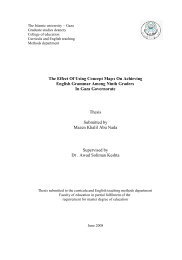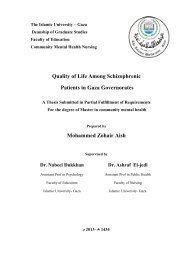developing a model for integrating safety, quality and productivity in ...
developing a model for integrating safety, quality and productivity in ...
developing a model for integrating safety, quality and productivity in ...
Create successful ePaper yourself
Turn your PDF publications into a flip-book with our unique Google optimized e-Paper software.
The construction <strong>in</strong>dustry is often criticized <strong>for</strong> its poor per<strong>for</strong>mance (e.g. low<strong>productivity</strong>, waste, health <strong>and</strong> <strong>safety</strong> problems) (Hoonakker et al, 2002). Safety isone of the major factors that affect construction <strong>in</strong>dustry <strong>and</strong> should be studied <strong>and</strong><strong>in</strong>vestigated <strong>in</strong> order to be <strong>in</strong>tegrated as an <strong>in</strong>herent culture of each member of theconstruction project. H<strong>in</strong>ze et al (1996) suggested that <strong>in</strong> order to conduct a successfulresearch study <strong>in</strong> construction <strong>in</strong>dustry, it is important that the research focus be onthose segments of the <strong>in</strong>dustry that truly warrant it.Safety cannot be considered as luxury. On the contrary, it is a human need firstlywhich emphasizes the need <strong>for</strong> mak<strong>in</strong>g it an <strong>in</strong>tegral part of construction projects.Th<strong>in</strong>k<strong>in</strong>g of <strong>safety</strong> as a human <strong>and</strong> f<strong>in</strong>ancial issue <strong>in</strong>creases the need <strong>for</strong> thecont<strong>in</strong>uous improvement of <strong>safety</strong> measures until reach<strong>in</strong>g the Zero AccidentApproach. Improv<strong>in</strong>g <strong>safety</strong> rema<strong>in</strong>s a priority but despite <strong>in</strong>novations that reconceivethe relationship between plann<strong>in</strong>g <strong>and</strong> <strong>safety</strong>, no systematic theory or practice has yetbeen developed (Howell et al, 2002).There are many practices to improve <strong>safety</strong> <strong>in</strong> construction projects. Investigationsabout factors of <strong>safety</strong> to be improved have been conducted by many. H<strong>in</strong>ze (2003)mentioned many areas of <strong>safety</strong> that directly impact the improvement of <strong>safety</strong>per<strong>for</strong>mance as follows:i. Demonstrated management commitmentii.Safety staff<strong>in</strong>giii. Safety plann<strong>in</strong>giv. Orientation <strong>and</strong> tra<strong>in</strong><strong>in</strong>gv. Worker <strong>in</strong>volvementvi. Rewards <strong>and</strong> <strong>in</strong>centivesvii. Subcontract managementviii. Drug test<strong>in</strong>gix. Accident <strong>in</strong>vestigationsLarge construction projects have experienced more <strong>safety</strong> improvements than smallones. It is also necessary to add that large companies have always better <strong>safety</strong>conditions than medium or small ones. Hoonakker et al (2002) found <strong>in</strong> a research7
















